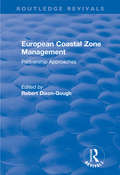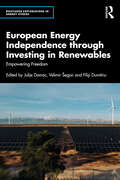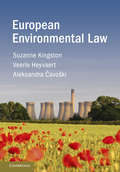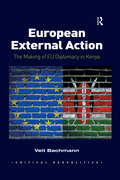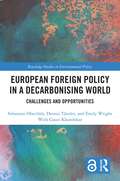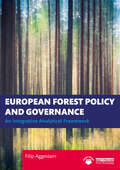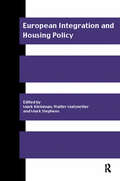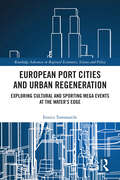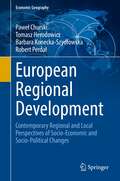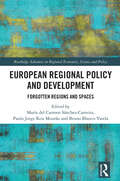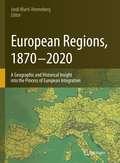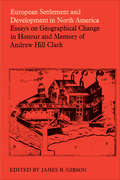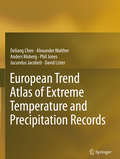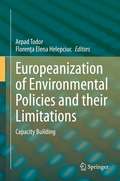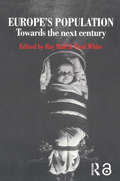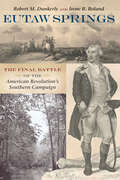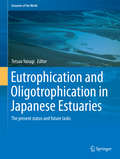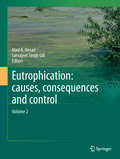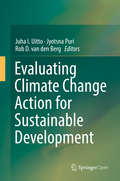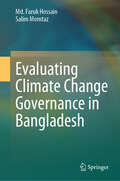- Table View
- List View
European Coastal Zone Management: Partnership Approaches (Routledge Revivals)
by Robert W. Dixon-GoughThis title was first published in 2001. Management of coastal zone areas is particularly complicated due to their international nature. Focussing on European coastal zones, this volume examines the various key issues and concerns and highlights the importance of partnership approaches. It details the inter-relationship between the various organizations involved (both governmental and none-governmental), as well as appraising the current national and international legislation and possible future policies. The contributors draw on in-depth case studies from the UK, the Baltic and Hellenic coasts and discuss topics such as international conflicts within the coastal zone, the effectiveness of planning legislation and how to appraise environmental and cultural impacts of changes in coastal zone land use.
European Energy Independence through Investing in Renewables: Empowering Freedom (Routledge Explorations in Energy Studies)
by Julije Domac Velimir Šegon Filip DumitriuThis book delves into Europe’s urgent quest for energy independence as a foundation for the EU and national sovereignty, economic resilience and climate leadership. Amid the rising geopolitical tensions and accelerating climate crises, it advocates for a bold shift towards renewable energy investments as a pathway to a sustainable, energy-secure future.Offering an in-depth exploration of policy innovations, strategic imperatives and case studies, the book highlights how decentralized energy systems and local empowerment can drive resilience and self-reliance. It underscores Europe’s potential to lead the global renewable energy transition, serving as a blueprint for other regions tackling energy insecurity and climate change. The book demonstrates how the EU and its nations can simultaneously enhance energy security and achieve their climate goals through strategic investment in renewables.The book is designed for policymakers, academics and energy professionals, particularly those involved in European energy, climate and economic strategies. It is also an essential resource for university professors and researchers in energy policy, international relations, sustainability and European studies. Regional and local leaders will find valuable insights on implementing transformative energy solutions tailored to their communities.
European Environmental Law (Routledge Research In European Union Law Ser.)
by Suzanne Kingston Veerle Heyvaert Aleksandra ČavoškiEU Environmental Law is a critical, comprehensive and engaging account of the essential and emerging issues in European environmental law and regulation today. Suitable for advanced undergraduate and postgraduate students, the book delivers a thematic and contextual treatment of the subject for those taking courses in environmental law, environmental studies, regulation and public policy, and government and international relations. Placing the key issues in context, EU Environmental Law takes an interdisciplinary and thematic approach to help students to better understand the implementation and enforcement of environmental law and policy across Europe. It offers an accessible overview, and links theory with practical applications that will allow students to contextualise the outcomes of legal rules and their impact on public and private behaviours. It provides a definitive account of the subject, examining traditional topics such as nature conservation law, waste law and water law, alongside increasingly important fields such as the law of climate change, environmental human rights law, and regulation of GMOs and nanotechnology.
European External Action: The Making of EU Diplomacy in Kenya (Critical Geopolitics)
by Veit BachmannEuropean External Action provides a critical assessment of the practice of EU diplomacy in a key site of Africa-European relations and the global development industry - the Kenyan capital of Nairobi. It analyses how the EU positions itself through its newly established diplomatic corps, the European External Action Service (EEAS), and how it is perceived as a collective geopolitical actor by its external cooperation partners. Going beyond existing studies on EU policy making in Brussels and African-European relations more generally, this book explores in a novel way the conduct of external relations and perceptions of the EU - abroad. Based on institutional ethnography within the EU Delegation in Nairobi and research affiliation with the University of Nairobi, as well as interviews with leading individuals of Kenyan-European interaction, it analyses the practices, processes and perceptions through which EU diplomacy is enacted and realised in a strategic node of global North-South relations. In light of the EU’s claim as a key partner for developing countries and its ambition to be a major player in global politics, European External Action thereby speaks not only to wider debates on the EU’s role as a global and development actor, but also provides new insights in the internal dynamics and the making of external agency in and through EU diplomacy.
European Foreign Policy in a Decarbonising World: Challenges and Opportunities (Routledge Studies in Environmental Policy)
by Sebastian Oberthür Gauri Khandekar Dennis Tänzler Emily WrightContributing to the emerging literature on the geopolitical and foreign policy implications of decarbonisation and energy transition processes, this book sheds light on the future of the European Union’s external relations under decarbonisation. Under the Paris Agreement on climate change, adopted in 2015, governments committed to phasing out the emissions of carbon dioxide and other greenhouse gases over the coming decades. This book addresses the many questions around this process of decarbonisation through detailed analyses of EU external relations with six fossil-fuel exporting countries: Nigeria, Indonesia, Azerbaijan, Colombia, Qatar and Canada. The authors systematically examine the six countries’ varying dependence on fossil fuels, the broader political and security context, current relations with the EU and the potential for developing these toward decarbonisation. In doing so, they put forward a series of findings that should hold across varying circumstances and provide a steppingstone to enrich and inspire further research on foreign policy, external relations and international relations under decarbonisation. The book also makes an important contribution to understanding the external implications of the 2019 European Green Deal. This volume will be of great interest to students and scholars of European environmental and climate policy, climate diplomacy, energy policy, foreign policy and climate/energy geopolitics.
European Forest Policy and Governance: An Integrative Analytical Framework
by Filip AggestamThis book provides a state-of-the-art overview covering distinct and relevant aspects of forest policy processes in Europe, presenting a fresh perspective on different analytical approaches, theories, and frameworks.Set against the background of a changing world, driven by significant social, environmental, and economic developments, in Europe and elsewhere, there is a growing need for an improved understanding of forest governance and how to analyse the forest policymaking processes. This book introduces the reader to some of the key issues typically encountered in reviewing proposed as well as established forest policies, focusing on five socially relevant topics for the forest-based sector today, namely: European forest governance under a green new deal Systemic changes and the circular (bio-)economy Social changes connected with forest ownership and forest actors Nature conservation and the pursuit of multifunctional forests Living with forest fires and climate change. In so doing, this book presents a set of timely and rich case studies relevant to the study of forest governance. In the final chapter, it puts forward an innovative and systematic method for selecting the most appropriate analytical tool that accounts for the constraints and objectives involved in monitoring forest policy. The book is accompanied by chapter-level exercises and online Support Material which details the various approaches, theories, and frameworks discussed in the book, providing direct links back to individual chapters, discussion points, and a step-by-step guide for how each method can be applied.This book will be an essential read for forestry students and scholars, and professionals and policymakers working on forest policy and forest management.
European Integration and Housing Policy (Routledge/rics Issues In Real Estate And Housing Ser.)
by Mark Stephens Mark Kleinman Walter MatznetterThis book presents a series of debates arising from the housing needs of different EU countries. The authors address key issues by examining in turn: * the consequences of European integration for different housing markets * the impact of the Maastricht Treaty and other policy documents * the social consequences of integration including income distribution, homelessness and marginal housing estates * current housing policy in the Nordic countries and in Eastern Europe.
European Landscape Dynamics: CORINE Land Cover Data
by Jan Tomas Gerard Gabriel Feranec Soukup Hazeu JaffrainFour unique pan-European CORINE Land Cover datasets—CLC1990, CLC2000, CLC2006, and CLC2012— and three datasets concerning changes between 1990 and 2012 have presented the first-ever opportunity to observe the European landscape by means of land cover and its change. This book brings together all these datasets to demonstrate the methods of identification, analysis and assessment of the European land cover and its changes that took place during the intervals of 1990–2000, 2000–2006, and 2006–2012. It provides examples in which CLC data plays a role in offering solutions to European environmental problems such as the monitoring of urban dynamics, land fragmentation, ecosystems mapping and assessment, and high nature value farmland characteristics. Existing environmental problems require new approaches, and European Landscape Dynamics: CORINE Land Cover Data indicates a set of outlooks for CLC data generation that produce more detailed levels of analysis and bottom-up approaches while addressing the relationship of CLC data to the Infrastructure for Spatial Information in Europe (INSPIRE). It also discusses the future of CLC data generation. A valuable resource of up-to-date information, it is useful to professionals such as scientists, territorial planners, and environmentalists as well as students of geosciences and all those who are interested in cognition of the European landscape, its changes and development.
European Port Cities and Urban Regeneration: Exploring Cultural and Sporting Mega Events at the Water's Edge (Routledge Advances in Regional Economics, Science and Policy)
by Enrico TommarchiCulture- and event-led regeneration have been catalysts for the transformation of redundant urban port areas and for the reframing of the image of many port cities, which notably feature among mega-event bidding and host cities. However, there is little understanding of the impacts of these processes on port-city relationships, as well as of how port city cultures shape mega events and the related regeneration strategies. This book examines the underexplored mutual links between, on the one hand, urban and socio-economic regeneration driven by cultural and sporting mega events and, on the other hand, the spatial, political and symbolic ties between cities and their ports. By adopting a cross-national, comparative perspective, with in-depth case studies (Hull, Rotterdam, Genoa and Valencia) and examples from other port cities across the world where mega events were held, the book engages with issues such as the tension between port and cultural uses, reactions and opposition to mega events in port cities, clashing urban imaginaries drawing on port activity and culture, the role of port authorities and companies in the city’s cultural life, the spectacularisation and commodification of local maritime culture and heritage, processes of cultural demaritimisation and remaritimisation of port cities. This book is therefore a contribution towards the bridging of port city and mega event studies, and it provides insights for port city policy makers and mega event promoters, drawing from a range of international experiences. The book also shows how societal and political change in the current ‘ontologically-insecure’ times may undermine the very paradigm of culture- and event-led regeneration in the years to come.
European Port Cities in Transition: Moving Towards More Sustainable Sea Transport Hubs (Strategies for Sustainability)
by Angela Carpenter Rodrigo LozanoSeaports, as part of urban centers, play a major role in the cultural, social and economic life of the cities in which they are located, and through the links they provide to the outside world. Port-cities in Europe have faced significant change, first with the loss of heavy industry, emergence of Eastern European democracies, and the widening of the European Community (now European Union) during the second half of the twentieth century, and more recently through drivers to change including the global Sustainable Development Agenda and the European Union Circular Economy Agenda.This book examines the role of modern seaports in Europe and consider how port-cities are responding to these major drivers for change. It discusses the broad issues facing European Sea Ports, including port life cycles, spatial planning, and societal integration. May 2019 saw the 200th anniversary of the first steam ship to cross the Atlantic between the US and England, and it is just over 60 years since the invention of the modern intermodal shipping container – both drivers of change in the maritime and ports industry. Increasing movements of people, e.g. through low cost cruises to port cities, can play a major role in changing the nature of such a city and impact on the lives of the people living there. This book brings together original research by both long-standing and younger scholars from multiple disciplines and builds upon the wider discourse about sea ports, port cities, and sustainability.
European Regional Development: Contemporary Regional and Local Perspectives of Socio-Economic and Socio-Political Changes (Economic Geography)
by Paweł Churski Tomasz Herodowicz Barbara Konecka-Szydłowska Robert PerdałThis book offers a comprehensive overview of contemporary issues of regional development. It places particular emphasis on its socio-economic and socio-political determinants which accompany the problem of existing and ever-widening differences in the level of regional development in various parts of Europe. In order to diagnose the scale of those differences and to indicate the main forces behind the divergence of development, the authors propose an original systematisation of regional development factors, drawing attention to the need to consider them within the framework of present-day socio-economic megatrends. The proposed approach to the development factors is also used for the author's operationalisation of the concept of territorial capital, which is at the centre of regional place-based policy. The wide spatial aspect of the analysis (national and local) and its extensive temporal scope (2004-2019) yields unique results and creates an important element of added value for this book, which shows the regularities of the process of regional development in Europe at three spatial levels - pan-European, national and intra-regional. Furthermore, it indicates the challenges faced by regionalists who attempt to carry out research on different territorial levels with a diverse number of units (205 EU regions, 16 Polish voivodeships, 2,478 Polish local units) and extended observation periods (2004-2017). The solutions proposed by the authors, who show the potential of overcoming the barriers resulting from limited access to complete and comparable statistical data series, should be inspiring for many researchers. The unique results of direct research carried out on a large sample of respondents and entrepreneurs via diverse field research techniques constitute a valuable source of information on local conditions that impact contemporary development processes in less developed regions. Their value is even greater because they were carried out in a unique laboratory created by the authors for testing the regularity of formation and impact of socio-economic development factors in various locally determined conditions of this process. It consists of purposefully selected test units (LAU2). Located in a less developed region, they represent all growth types and functional test units identified in the course of the research. Consequently, the results obtained may be generalised and applied to other areas showing similar features of territorial capital. The monograph is addressed primarily to a wide group of regionalists connected with economic and social sciences as well as to practitioners involved in the implementation of development policies at various levels.
European Regional Policy and Development: Forgotten Regions and Spaces (Routledge Advances in Regional Economics, Science and Policy)
by María del Carmen Sánchez-Carreira Paulo Jorge Reis Mourão Bruno Blanco-VarelaThe shortcomings of traditional regional policies led to a major policy. Thus, regions have become more active in the design and implementation of policies, following a bottom-up approach and involving the participation of the local community in strategic planning, as opposed to the traditional top-down method. This book addresses regional development theories and policies, with a special focus on forgotten places, and raises emerging questions about recent theoretical advances, as well as trends and challenges in the field. It examines two main and related issues: the crucial role of regional actors for development and the role of Forgotten Spaces. It emphasizes the spatial/territorial approaches from different theoretical perspectives, underlining place-based approaches and compares the experiences of both successful and failed cases, attempting to identify lessons and policy recommendations, as well as adding empirical evidence to this field. The different cases presented, which focus on Forgotten Spaces, allow the reader to assess the role of different actors for regional development as well as some sectoral approaches. While there is a clear focus on European countries with different geographical, institutional and sociocultural characteristics, the book also examines good and bad examples of regional development and policies related to forgotten places from different regions worldwide, including developed and developing countries. The book benefits from contributions from over 20 authors from different nationalities, and a rich diversity of case studies, approaches and methods of discussion. The authors discuss practical examples and more complex theoretical approaches, involving techniques of spatial analysis, spatial econometrics, social networks, content analysis as well as regional planning techniques. The book will appeal to an interdisciplinary audience and will provide academicians, politicians, and policy designers with original and detailed analyses.
European Regions and Boundaries: A Conceptual History (European Conceptual History #3)
by Diana Mishkova Balázs TrencsényiIt is difficult to speak about Europe today without reference to its constitutive regions—supra-national geographical designations such as “Scandinavia,” “Eastern Europe,” and “the Balkans.” Such formulations are so ubiquitous that they are frequently treated as empirical realities rather than a series of shifting, overlapping, and historically constructed concepts. This volume is the first to provide a synthetic account of these concepts and the historical and intellectual contexts in which they emerged. Bringing together prominent international scholars from across multiple disciplines, it systematically and comprehensively explores how such “meso-regions” have been conceptualized throughout modern European history.
European Regions, 1870 – 2020: A Geographic and Historical Insight into the Process of European Integration
by Jordi Martí-HennebergThis volume explains the national and regional border modifications that took place in Europe from 1870 to 2020. It provides insights that allow us to understand boundary changes for several different levels of territorial organization. The text describes the state formation process related to the regional-administrative structures in each European country, and offers insight into the degree of centralization historically by describing the extent of legislative autonomy at different administrative levels and the competences reserved for each of them. The book sheds light on the complex regional organization of Europe and the difficulties its reform has faced. The main audience will be academics and PhD/Masters students working in a variety of geography fields, and the maps included in each chapter will also be of interest to a broader audience including undergraduate and secondary-school students wishing to better understand the political history of Europe.
European Settlement and Development in North America
by James R. GibsonAndrew Hill Clark (1911-1975) was responsible for much of the recent rise of historical geography in North America. The focus on his research was the opening of New World lands by European peoples, and this North American experience is the subject of this collection of essays written by eight of Clark's students. They examine the role of a new physical and economic environment – particularly abundant and cheap land – in the settlement of New France, the cultural and physical problems that conditioned Russian America, the transformation of cultural regionalism in the eastern United States between the late colonial seaboard and the early republican interior, the changing economic geography of rice farming on the antebellum Southern seaboard, the interrelationships of the European and Indian economies in the pre-conquest fur trade of Canada, differential acculturation and ethnic territoriality among three immigrant groups in Kansas in the late nineteenth and early twentieth centuries, the development in England and the United States of similar social geographic images of the Victorian city, and the erosion of a sense of place and community by possessive individualism in eighteenth-century Pennsylvania. The essays are preceded by an appreciation of Clark as an historical geographer written by D.W. Meinig and are brought together in an epilogue by John Warkentin. The work is an unusually consistent Festchrift which should appeal to all interested in the patterns of North American settlement.
European Spatial Data for Coastal and Marine Remote Sensing: Proceedings of International Conference EUCOMARE 2022-Saint Malo, France
by Simona NiculescuThis volume presents full paper contributions from the International Conference of European Spatial Data for Coastal and Marine Remote Sensing (EUCOMARE) 2022, with the support of the ERASMUS+ Programme of the European Union, held in Saint Malo, France. EUCOMARE aims to promote academic and technical exchange on coastal related studies including coastal environmental and socio-economic issues, with the use of European remotely sensed data. The book is an excellent resource for scientists, engineers, and programme managers eager to learn about the recent developments and achievements in the field of remote sensing applications on marine and coastal areas. Readers will learn about recent advances in sensors' radiometric, spatial, temporal and spectral resolution, as well as new data processing approaches in remote sensing for monitoring and mapping the various characteristics of marine, coastal and aquatic systems.
European Trend Atlas of Extreme Temperature and Precipitation Records
by Phil Jones Deliang Chen Alexander Walther Anders Moberg Jucundus Jacobeit David ListerThis Atlas presents records of climatic variability and change in Europe starting before 1901 and focuses especially on trends of extreme temperatures and precipitation. The authors have used software developed within EMULATE (European and North Atlantic daily to MULtidecadal climATE variability) to obtain the extremes indices and temporal trends. The trend atlas provides an easy way to identify spatial patterns for a given time period, region, season, and index. The Atlas clearly shows that climate in Europe has changed over the last 100 to 150 years, such that the occurrence and intensity of warm temperature extremes have increased. Precipitation extremes have also changed, but with a less clear pattern compared to the temperature extremes.
Europeanization of Environmental Policies and their Limitations: Capacity Building
by Arpad Todor Florenţa Elena HelepciucThis book offers a window into the mechanisms that drive events when countries with poor track records in environmental protection and low administrative capacity, join an organisation with ambitious environmental regulatory regimes, which include some of the highest environmental protections standards in the world.This book examines the institutional building capacity in Romania after two decades of the development of the EU's environmental policy on elaboration, transposition, implementation, monitoring and institutional building. The book examines how Romania has fared as one of the least environmentally friendly EU member states, and poses the following questions. What are the limits of Europeanisation in the area of public policies? What is the reason why, despite the overwhelming public interest in environmental issues, and widespread agreement that urgent action to protect the environment and prevent catastrophic climate change are paramount, the pace of achieving the goals is remains slow. Why do policies fail?This book brings together several case studies focusing on the evolution of environmental policies in Romania over the last twenty years, with a special focus on the post-accession period (2007 onwards). The book provides an analysis of policies, where progress is less than satisfactory, and examines why this is the case.
Europes Population: Towards The Next Century
by Paul White Ray HallFirst published in 1995. Routledge is an imprint of Taylor & Francis, an informa company.
Eutaw Springs: The Final Battle of the American Revolution's Southern Campaign
by Robert M. Dunkerly Irene B. BolandAn in-depth analysis of one of the War for Independence’s bloodiest and least understood conflicts.The Battle of Eutaw Springs took place on September 8, 1781, and was among the last in the War of Independence. It was brutal in its combat and reprisals, with Continental and Whig militia fighting British regulars and Loyalist regiments. Although its outcome was seemingly inconclusive, the battle, fought near present-day Eutawville, South Carolina, contained all the elements that defined the war in the South. In Eutaw Springs: The Final Battle of the American Revolution’s Southern Campaign, Robert M. Dunkerly and Irene B. Boland tell the story of this lesser known and under-studied battle of the Revolutionary War’s Southern Campaign. Shrouded in myth and misconception, the battle has also been overshadowed by the surrender of Yorktown.Eutaw Springs represented lost opportunities for both armies. The American forces were desperate for a victory in 1781, and Gen. Nathanael Greene finally had the ground of his own choosing. British forces under Col. Alexander Stewart were equally determined to keep a solid grip on the territory they still held in the South Carolina lowcountry.In one of the bloodiest battles of the war, both armies sustained heavy casualties with each side losing nearly twenty percent of its soldiers. Neither side won the hard-fought battle, and controversies plagued both sides in the aftermath. Dunkerly and Boland analyze the engagement and its significance within the context of the war’s closing months, study the area’s geology and setting, and recount the action using primary sources, aided by recent archaeology.“A well put together book that is easy to read, and it makes good use of graphic material. Eutaw Springs is recommended.” —The Journal of America’s Military Past“A long-overdue study of . . . Nathanael Greene’s last main force Southern campaign engagement. Drawing from a wealth of resources including new research, archaeology and pension documents, the authors have created an easy reading account. . . . For students of the Revolutionary War, this is must reading because so much focus has been directed at Yorktown where the British abandoned an army instead of the more mobile war in the South where the war was finally won by wearing down the British.” —Lawrence Babits, George Washington Distinguished Professor of History, East Carolina University“A very good analysis of the political, military, and physical environment, with some profiles of a number of interesting people, most notably Nathanael Greene, after Washington the most important American general of the war, though he never won a battle.” —New York Military Affairs Symposium Review
Eutrophication and Oligotrophication in Japanese Estuaries
by Tetsuo YanagiThis book presents lessons learnt from Japan's past, in relation to coastal waters, industrial pollutants and concentrated urban populations. It examines ecosystem damage and pollution in coastal sea areas and addresses the question: What is the present status of Japanese estuaries from the view point of eutrophication and oligotrophication? The authors describe three typical situations, namely eutrophication problems in Tokyo Bay, oligotrophication problems in the Seto Inland Sea, and the disappearance of hypoxia in Dokai Bay. Readers will learn how legal controls on Total Phosphorus (TP) and Total Nitrogen (TN) loads have played an important role in each of these three bays. They will see that the results of the application of the law differ among the three bays as the characteristics of material cycling are different. The roles of community activities, water related technology development and local characteristics emerge, as responses to problems of environmental deterioration and future tasks are all investigated in this publication. The book will appeal to anyone with an interest in maintaining healthy estuaries, or in coastal water environment affairs and governing systems.
Eutrophication: Causes, Consequences and Control
by Sarvajeet Singh Gill Abid A. AnsariEutrophication continues to be a major global challenge and the problem of eutrophication and availability of freshwater for human consumption is an essential ecological issue. The global demand for water resources due to increasing population, economic developments, and emerging energy development schemes has created new environmental challenges for global sustainability. Accordingly, the area of research on eutrophication has expanded considerably in recent years. Eutrophication, acidification and contamination by toxic substances are likely to pose increasing threats to freshwater resources and ecosystems. The consequences of anthropogenic-induced eutrophication of freshwaters are severe deterioration of surface waters and growing public concern, as well as new interest among the scientific community. "Eutrophication: causes, consequences & control" provides the latest information on many important aspects of the processes of natural and accelerated eutrophication in major aquatic ecosystems around the world. This book offers a cutting-edge resource for researchers and students alike who are studying eutrophication in various ecosystems. It presents the latest trends and developments in the field, including: global scenarios and local threats to the dynamics of aquatic ecosystems, economics of eutrophication, eutrophication in the great lakes of the Chinese pacific drainage basin, photoautotrophic productivity in eutrophic ecosystems, eutrophication's impacts on natural metal remediation in salt marshes, phytoplankton assemblages as an indicator of water quality in seven temperate estuarine lakes in southeast Australia, biogeochemical indicators of nutrient enrichments in wetlands - the microbial response as a sensitive indicator of wetland eutrophication, and ultraviolet radiation and bromide as limiting factors in eutrophication processes in semi-arid climate zones. Written by respected experts and featuring helpful illustrations and photographs, "Eutrophication: causes, consequences & control" provides a concise and practical update on the latest developments in eutrophication.
Eutrophication: Process Management Strategies (Springer Water)
by Elena Neverova-Dziopak Zbigniew KowalewskiThis book critically analyzes the reasons for the lack of tangible success in preventing progressing eutrophication and its negative effects as a global environmental problem without a clear solution until now. Particular attention of the authors will be paid to the currently existing approaches to setting the ecological standards for the nutrients content in surface waters and wastewater, the appropriate selection of wastewater treatment technology, the issues of monitoring and trophic status assessment, and the approach to managing this process. Also, the book provides a proposed systemic approach to managing the eutrophication process to mitigate its dangerous ecological, economic, and social effects and to preserve the biospheric functions of aquatic ecosystems.The target audience for this book - a wide range of specialists in water management and protection, water-and-wastewater technologies, and spatial planning, as well as lawyers and economists for environmental protection, medical workers, upper undergraduate students, postgraduate students, researchers and stakeholders.
Evaluating Climate Change Action for Sustainable Development
by Juha I. Uitto Jyotsna Puri Rob D. van den BergThis book is open access under a Creative Commons license. This authoritative book presents the ever progressing state of the art in evaluating climate change strategies and action. It builds upon a selection of relevant and practical papers and presentations given at the 2nd International Conference on Evaluating Climate Change and Development held in Washington DC in 2014 and includes perspectives from independent evaluations of the major international organisations supporting climate action in developing countries, such as the Global Environment Facility. The first section of the book sets the stage and provides an overview of independent evaluations, carried out by multilateral development banks and development organisations. Important topics include how policies and organisations aim to achieve impact and how this is measured, whether climate change is mainstreamed into other development programs, and whether operations are meeting the urgency of climate change challenges. The following sections focus on evaluation of climate change projects and policies as they link to development, from the perspective of international organisations, NGO's, multilateral and bilateral aid agencies, and academia. The authors share methodologies or approaches used to better understand problems and assess interventions, strategies and policies. They also share challenges encountered, what was done to solve these and lessons learned from evaluations. Collectively, the authors illustrate the importance of evaluation in providing evidence to guide policy change to informed decision-making.
Evaluating Climate Change Governance in Bangladesh
by Salim Momtaz Md. Faruk HossainThis book would be a valuable reference book for academics teaching and researching climate change and environmental governance. This book would be useful to students studying environmental planning, science and management, and social sciences – especially, human geography, environmental sociology, development studies, and community engagement. The book will have an audience in both developed and developing countries due to the global significance of climate change and universal nature of human vulnerability to climate change. International development organizations working in developing countries such as World Bank, Asian Development Bank, United Nation&’s Development Program and international and local NGOs like World Vision, CARE International and Grameen Bank and their workers would be particularly interested since many of these organizations have specific programs for climate affected regions.
